|
|
 |
Fiche d'espèce de Copépode |
|
|
Calanoida ( Ordre ) |
|
|
|
Clausocalanoidea ( Superfamille ) |
|
|
|
Euchaetidae ( Famille ) |
|
|
|
Paraeuchaeta ( Genre ) |
|
|
| |
Paraeuchaeta gracilis (Sars, 1905) (F,M) | |
| | | | | | | Syn.: | Euchaeta gracilis Sars, 1905 b (p.16, Rem.F); Farran, 1926 (p.255); Vervoort, 1957 (p.77); 1963 b (p.168, figs.M, Rem.); Grice & Hulsemann, 1967 (p.15); Park, 1975 c (p.16, figs.F,M); Dessier, 1979 (p.205); Roe, 1984 (p.357); Brenning, 1984 (p.3, Rem.); 1985 a (p.28, Table 2); Baessa-de-Aguiar, 1989 (1992) (p.111, figs.F); 1991 (1993) (p.106); Mauchline, 1992 a (p.2, 3); Hays & al., 1994 (tab.1); Mauchline, 1994 a (p.561); 1999 (N°182, p.8, figs.F,M); Beaugrand & al., 2002 (p.1692); Beaugrand & al., 2002 (p.179, fig.5, 6); Alvarez-Fernandez & al., 2012 (p.21, Rem.: Table 1);
? Euchaeta hebes valida T. Scott, 1894 b (p.60, figs.M);
Euchaete gracilis : With, 1915 (p.185, fig.F);
Euchaeta quadrata Farran, 1908 b (p.43, figs.F); Wolfenden, 1911 (p.297, figs.F);
E. barbata : T. Scott, 1894 b (p.58);
Pareuchaeta gracilis : Sars, 1925 (p.120, figs.F,M); Rose, 1933 a (p.123, figs.F,M); Jespersen, 1934 (p.81); Lysholm & al., 1945 (p.23); Marques, 1959 (p.210); Paiva, 1963 (p.44); Macdonald & al., 1972 (p.213, hydrostatic pressure effect); Gaudy, 1975 (p.109, fig.1, Table I, 4, respiration); Vives, 1982 (p.291); Mauchline, 1998 (tab.30, 42, 58); Conover & Gustavson, 1999 (p.41, tab.6); Holmes, 2001 (p.52) ; Zaafa & al., 2014 (p.67, Table I, occurrence) | | | | Ref.: | | | Sewell, 1929 (p.154); 1947 (p.120); 1948 (p.501); De Decker & Mombeck, 1964 (p.13); Bradford & al., 1983 (p.23); Park, 1994 (p.319); 1995 (p.78, Rem.F, M, figs.F,M); Bradford-Grieve & al., 1999 (p.880, 926, figs.F,M); Vives & Shmeleva, 2007 (p.662, figs.F,M, Rem.) |  issued from : T. Park in Bull. Scripps Inst. Oceanogr. Univ. California, San Diego, 1995, 29. [p.185, Fig.75]. Female: a, forehead (left side); b, urosome (left); c, d, e, genital somite (left, right, ventral, respectively); f, Mx1 (first inner lobe omitted), posterior; g, P1 (anterior); h, P2 (anterior). Nota: Laterally, rostrum pointing obliquely forward at angle of about 10° with respect to anterodorsal margin of forehead. Cephalosomal appendages, including Mx1 and swimming legs as in P. exigua with minor exception that in P2 exopod , 2nd outer spine of 3rd segment relatively long, reaching or extending slightly beyond base of following outer spine. Male: i, forehead (left); j, exopodod P1 (anterior); k, exopod of P2 (anterior); l, exopod of left 5th leg (medial); m, distal end of left 5th leg exopod (medial, tilted counterclockwise); n, second exopodal segment of left 5th leg (anterior, tilted counterclockwise).
|
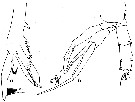 issued from : W. Vervoort in Atlantide Report., 1963, 7. [p.169, Fig.17]. As Euchaeta gracilis. Male (from Angola-Sierra Leone): a, extremity of exopodite of left P5 (x145); b, P5 and urosome (left side) (x28). Nota: The males found together with female differ in minor particulars fro Sars' figures and descriptions. The lamella on the 2nd left exopodal segment of P5 is not hillowed, but it is distinctly cultriform and terminates in a strong internally curved, dagger-shaped point. There is a row of strong, acute spines on the posterior aspect of the 2nd left exopodal segment, preceded by a strong spine. There is much variability in the size of the spines of the internal row and the length of the cultriform process. The length of the dagger-shaped end of the lamella varies greatly; some males, that have a strongly developed dagger-shaped spine, approach Euchaeta norvegica Boeck fairly closely. Specimens with a short dagger-shaped end of the lamella approach the type figured by Sars (1925).
|
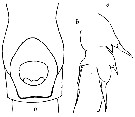 issued from : R.N. Wolfenden in Die Marinen Copepoden der Deutschen Südpolar-Expedition 1901-1903, 1911. [p.297, Fig.49]. As Euchaeta quadrata. Female: a, genital segment (ventral); b, outer margin of exopod of P1; c, outer margin of P2.
|
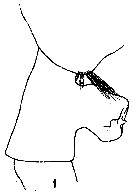 issued from : R.N. Wolfenden in Die Marinen Copepoden der Deutschen Südpolar-Expedition 1901-1903, 1911. [Pl.XXXV, Fig.1]. As Euchaeta quadrata. Female: genital segment (lateral, right side).
|
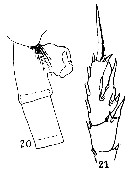 issued from : G.P. Farran in Fish. Ire. Sci. Invest., 1906, II [1908]. [Pl. III, Figs.20-21]. As Euchaeta quadrata. Female (from W Ireland): 20, genital segment (lateral); 21, exopod of P2. Nota: This species is easily recognised by its very large protruding genital swelling, which appears almost square in lateral view.
|
 issued from : J. Mauchline in ICES Ident. Leafl. Plankton, 1999, N°182. [p.3, Fig.2: 16a]. As Euchaeta gracilis. Female (Northeast Atlantic): 16a, genital double-somite (left side).
|
 issued from : J. Mauchline in ICES Ident. Leafl. Plankton, 1999, N°182. [p.4, Fig.3: 16b]. As Euchaeta gracilis. Male (Northeast Atlantic): 16b, terminal two segments, exopodal segments of left P5.
|
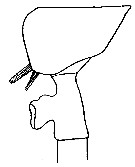 issued from : C. With in The Danish Ingolf-Expedition, 1915, III (4). [p.186, Text-Fig.55]. As Euchaeta gracilis. Female (W coast of Ireland): Last thoracic segment and genital segment (left side); Nota: The lateral corners are not regularly rounded, but somewhat squarely truncate. The genital segment is distinctly shorter than the following two, but 1.5 as long as the second, with a very prominent genital protuberance. Genital area surrounded by a chitinous system. A1 extend scarcely to the end of the thorax; segment 20 as long as the segment 24-25, and the 23 as long as the 16. The outer lobe of Mx1with 9 bristles, of which the 2 proximal are moderately short; the basipod 3 has 4 setae and the three segments of endopod have 3 setae each. The outer seta of exopod 1 is represented by a small protuberance.
|
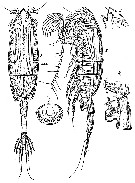 Issued from : G.O. Sars in Résult. Camp. Scient. Prince Albert I, 69, pls.1-127 (1924). [Pl. XXXIII, figs.1-5]. As Pareuchaeta gracilis. Female: habitus (dorsal); 2, idem (lateral left side); 3, forehead (lateral); 4, posterior part cephalothorax and genital somite (lateral left side); 5, genital complex (ventral).
|
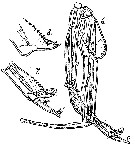 Issued from : G.O. Sars in Résult. Camp. Scient. Prince Albert I, 69, pls.1-127 (1924). [Pl. XXXIII, figs.6-8]. As Pareuchaeta gracilis. Male: 6, P5; 7, distal end of left P5 (enlarged); 8, idem (enlarged).
|
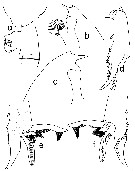 issued from : T. Park in Smiths. Contr. Zool., 1975, 196. [p.16, Fig.13]. As Euchaeta gracilis. Female (G. of Mexico): a, genital segment (lateral); b, forehead (lateral). Male: c, forehead (lateral); d, exopod of left P5 (anterior); e, same (lateral); f, same (medial). Nota: Most of specimens were found in the samples obtained from a depth range of 500 to 1000 m.
|
 Paraeuchaeta gracilis Paraeuchaeta gracilis Female: 1 - See key to species Groups and independent species of Paraeuchaeta (p.30). 2 - Laterally, genital field facing ventrad, with large tubercular outgrowth behind genital orifice (Fig.75-c). 3 - Genital somite without transverse ridge on ventral side anterior to genital prominence (Fig.75-c). 4 - Laterally, genital flange low and inconspicuous (Fig.75-c). 5 - Laterally, genital prominence extremely tall (Fig.75-c).
| | | | | Ref. compl.: | | | Roe, 1972 (p.277, tabl.1, tabl.2); Suarez-Morales & Gasca, 1998 a (p.109); Lapernat, 2000 (tabl.3, 4); CPR, 2004 (p.58, fig.170); Teuber & al., 2013 (p.1, Table 2, 3, fig. 5, respiration rates, enzyme activity); Bode & al., 2015 (p.268, Table 1, 2, figs.3, 4, chemical components, trophic level, geographic zone); El Arraj & al., 2017 (p.272, table 2, spatial distribution); Bode & al., 2018 (p.840, Table 1, respiration & ingestion rates, depth) | | | | NZ: | 7 | | |
|
Carte de distribution de Paraeuchaeta gracilis par zones géographiques
|
| | | | | |  Issued from : M. Bode, R. Koppelmann, L. Teuber, W. Hagen & H. Auel inGlobal Biogeochemical Cycles, 2018, 32. [p.844, Table 1). Issued from : M. Bode, R. Koppelmann, L. Teuber, W. Hagen & H. Auel inGlobal Biogeochemical Cycles, 2018, 32. [p.844, Table 1).
Cf. explanations of these measures in Calanoides natalis from the same authors.
Compare with Euchaeta marina, Paraeuchaeta aequatorialis. |
| | | | Loc: | | | South Africa (E), Angola, off S St. Helena Is., Congo, G. of Guinea, Roxo Cap, off E St. Paul Is., Cape Verde Is., off Mauritania, off Morocco-Mauritania, Canary Is., off Madeira, off W Tazngier, off W Cabo Finisterre, Azores, off Amazon, Caribbean Sea, G. of Mexico, Bay of Biscay , off W & SW Ireland, off Rockall Is., Barrow Strait, S Davis Strait, S Iceland, Faroe Is., W Indian, [[ Philippines, China Seas, Aleutian Is., G. of Alaska, British Columbia, Hawaii, NE Easter Is. (in C. B. Wilson, 1950, p.281) | | | | N: | 43 | | | | Lg.: | | | (1) F: 6,8; (3) F: 6,9-6,4; M: 5,8-5,2; (7) F: 6,74; (10) F: 6-5,85; (14) F: 6,7-5,8; M: 5,4-5,05; (19) F: 6,66-6,0; M: 5,58-5,08; (24) F: 6,9; (38) F: 6,84-6,8; M: 6,5-5,5; (54) F: 6,9; (73) F: 6,91-6,44; (199) F: 7,04-6,4; M: 6,08-5,44; (806) F: 6,38-6,13; (1111) F: 6,0-6,6; M: 5,3; {F: 5,80-7,04; M: 5,05-6,50} | | | | Rem.: | méso-bathypélagique.
Les localisations données par C.B. Wilson (1950) dans le Pacifique (marked [[...]] ) ne sont pas retenues par Park (1994, 1995).
Voir aussi les remarques en anglais | | | Dernière mise à jour : 28/10/2022 | |
|
|
 Toute utilisation de ce site pour une publication sera mentionnée avec la référence suivante : Toute utilisation de ce site pour une publication sera mentionnée avec la référence suivante :
Razouls C., Desreumaux N., Kouwenberg J. et de Bovée F., 2005-2025. - Biodiversité des Copépodes planctoniques marins (morphologie, répartition géographique et données biologiques). Sorbonne Université, CNRS. Disponible sur http://copepodes.obs-banyuls.fr [Accédé le 03 juillet 2025] © copyright 2005-2025 Sorbonne Université, CNRS
|
|
 |
 |













